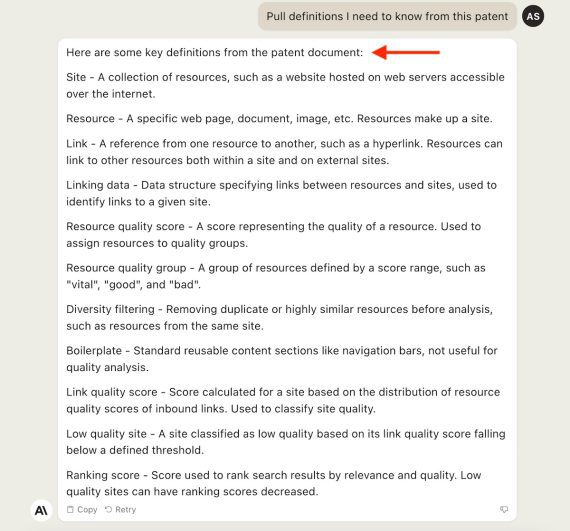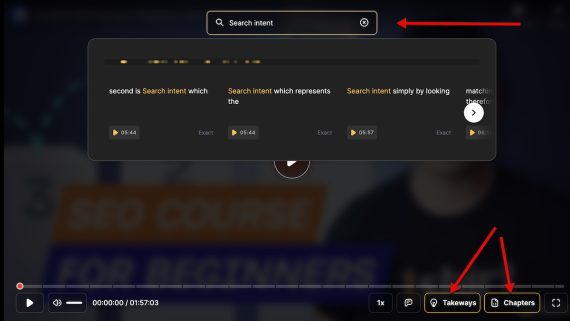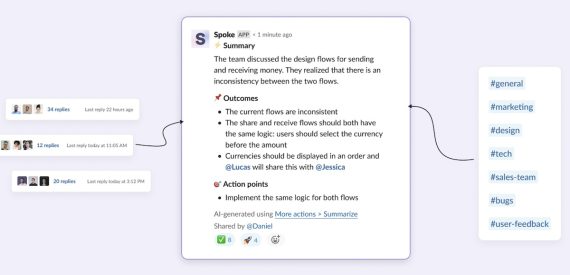Generative synthetic intelligence is highly effective for analyzing and summarizing content material. Listed below are 4 revolutionary instruments for that process.
Claude for PDFs
Studying lengthy stories is difficult in an period of knowledge overload. I’ve tried many doc condensers, however nothing was higher than ChatGPT. Then I discovered Anthropic’s Claude, which analyzes and condenses textual content, together with PDFs.
To check, I uploaded to Claude the PDF of Google’s patent in 2015 for classifying websites as low-quality. Claude produced an knowledgeable, condensed clarification with out an excessive amount of element.
Per Claude, the patent:
- Assigns a high quality rating for every useful resource linking to a web site.
- Teams the assets primarily based on their rating ranges.
- Counts the variety of assets in every group.
- Calculates a weighted common hyperlink high quality rating for the location utilizing the distribution of assets within the teams.
- Classifies the location as low high quality if the hyperlink high quality rating is under a threshold.
- Can lower rankings in search outcomes of low-quality websites.
In brief, it classifies websites as low high quality primarily based on their backlinks.
Claude permits for changes within the prompts for extra detailed summaries, definitions, chapter creation, and extra. Like ChatGPT, Claude saves all dialog so customers can return and request extra refinements and information.
Use Claude to:
- Create takeaways of your individual content material.
- Perceive lengthy and complex paperwork.
- Summarize content material in several codecs, reminiscent of paragraphs, tables, or lists.
- Create glossaries from any doc.
Claude pulled these definitions from Google’s patent.

Claude analyzes and condenses textual content, reminiscent of a PDF for a Google patent. Click on picture to enlarge.
Glasp for Internet Pages
Glasp condenses textual content from internet pages. Customers spotlight sections of a web page. Glasp will then create a abstract whereas preserving the unique for comparability.
Use Glasp to:
- Curate your content material for newsletters, social posts, or blogs.
- Educate your workforce by sharing summarized assets.

Glasp condenses textual content from highlighted sections of internet pages, reminiscent of this instance from Animalz, a content material advertising and marketing web site. Click on picture to enlarge.
Spext for YouTube Movies
Spext condenses and organizes audio and video. It really works nicely for podcasts and YouTube movies by permitting customers to decide on the sections to research.
Spext breaks YouTube movies into chapters (with textual content), permitting viewers to navigate to related components and skim the remainder. There’s additionally a search choice to seek out information throughout the video.
Use Spext to:
- Flip prolonged product demos into shorter sections which can be simpler to navigate.
- Create programs from lengthy movies.
- Create summaries and takeaways from your individual movies.

Spext breaks YouTube movies into chapters, permitting viewers to navigate to related components and skim the remainder. Click on picture to enlarge.
Spoke for Slack
Slack is a terrific device for inner communication and exterior collaborations, but it surely’s simply cluttered.
Spoke makes use of AI to generate every day digests of Slack channels. Present Spoke entry to Slack, and also you received’t must learn all of the threads. You’ll get a helpful digest of the earlier weekday by 9 a.m.


